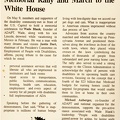Washington Post, Monday May 10, 1993 D1
METRO
Photo by Gerald M , The Washington Post: With the US Capitol dome behind them, ADAPT protesters march at the camera. In the front row left to right are Rick James in his signature mountain man hat, Stephanie Thomas, Frank Lozano and his dog guide Frazier, and Paulette Patterson with her fist raised. Behind her a man holds a large poster that reads "Do Not Tread on Disability."
Caption reads: Asking for more financial aid for the disabled so they can live independently, hundreds of demonstrators march from the Capitol to the White House.
[On the right side of the picture is another article about protests against gun violence. on the left side is the article about ADAPT.]
[Headline] A Cry for Freedom and an Outcry Over the Killings:
Demonstrators for Disabled Seek Funds for Independent Living
By Liz Spayd, Washington Post staff writer
Waving signs and chanting. ‘Free our people now,‘ hundreds of disability rights advocates from across the country rolled their wheelchairs down Pennsylvania Avenue to the White House yesterday in a peaceful but boisterous demonstration for better treatment of the disabled.
The demonstrators, many of them quadriplegics and paraplegics, are fighting for money that would allow more of the disabled to live independently instead of in nursing homes. Some have said they intend to stage disruptive events in downtown Washington today to draw attention to their cause.
‘What we need is more money for others to have the freedom I have now,‘ said Jack Urbany, of Pennsylvania, who until last year lived in a nursing home "I'm so happy to be free."
Because many people with disabilities don't have jobs, financing a trip to Washington meant holding garage sales. selling buttons and organizing letter-writing campaigns to raise funds.
Their willingness to make the effort is in part testament to the Americans With Disabilities Act, whose enactment last year is helping to forge a new civil rights movement in the United States.
The ranks of the disabled agitating for better treatment has swelled since the law was passed, according to activists, because it empowered
See PROTEST, D4, Col I
[Headline] A Chain of Remembrance Links Protesters Against Gun Violence
By Serge F. Kovaleski, Washington Post Staff Writer
The pink dress that once adorned a spry 7-year-old girl who was gunned down as she rode her snowmobile. The Statue of Liberty brandishing a handgun, her crown lined with bullets. Tombstones, and wistful odes to the dead.
Those were among the more than 1,200 links that made up the Chain of Remembrance, a sprawling patchwork of mementos, grief and outrage that was the symbolic centerpiece of an emotional Mother's Day rally against gun violence at the Lincoln Memorial.
Several hundred demonstrators, relatives of the slain and gun control advocates, ringed the Reflecting Pool yesterday, holding 18-by-18-inch cloth threaded together in honor of the dead. A church choir sang "Battle Hymn of the Republic."
Demonstrators also hoisted placards decrying the National Rifle Association and wore T-shirts emblazoned with names, words of remembrance and, in some cases, photographs and sketches of slain loved ones.
Others sat inconspicuously under the brilliant sunlight, crying as they reflected on the cruel fates of their dead relatives and how such tragedy, in a flash, has thrown their own lives into turmoil. For some, it was a chance to share their wrenching tales of misfortune.
"Everyday, every minute and every second of our lives has
[See Violence, D4, Col. 3]
[Headline] Hundreds Demand Better Treatment for Disabled Better Treatment for Disabled in D.C. Rally
PROTEST, From D1
physically and mentally impaired people with the same rights as other minority groups.
At a rally on the west steps of the Capitol, march leaders said that although their fight for equal rights was strengthened by the disabilities act, many improprieties still exist.
‘What is inappropriate is millions of human beings living with less dignity than we accord our pet dogs and 'ats,' Justin Dart, head of a small federal agency devoted to disability issues. told the crowd. "What is inappropriate is American citizens impirisoned without due process of law."
The protesters, in a line, wheeled their way up Pennsylvania Avenue from the Capitol to the White House, where they arrayed themselves in single file along the long iron fence in front of the north lawn. There they placed white crosses on the lawn symbolizing the deaths of thousands of people from substandard and poor nursing home care.
‘This is kind of déja vu for me." said Paul Melvin of Norfolk, wiping away the sweat on his brow as he sat in his wheelchair in front of the White House gates. “l came in the late '60s and early '70s tor Vietnam protests."
His current cause, and that of other demonstrators, is to redirect one-fourth of the $23 billion that Medicaid budgets for nursing homes into programs that would enable those with disabilities to live at home. Failure to establish such a policy, group leaders say, forces 1.6 million people to live in the isolation of institutions instead of the mainstream of society.
Though a change in federal policy was the chief reason. many said they felt a sense of empowerment by participating in such an event.
"This is overwhelming. I've never experienced anything like this,“ said an exuberant lsabel Alvidrez, 23, of El Paso,
The demonstration, led by a Denver-based group called Adapt, was timed to pressure the Clinton administration to consider the rights of the disabled in its package of health-care revisions due out soon.
It is not the first time President Clinton has found himself the target of Adapt. While Clinton was governor of Arkansas, demonstrators shackled themselves to his office until he agreed to restore cuts in funding for in-home care for the disabled.
Last October, his San Francisco campaign headquarters was blocked for hours by dozens of wheelchair users who successfully pressured the candidate to include long-term care for the disabled in his plan for health-care revising.
Now, the demonstrators hope to hold Clinton to his promise. They are scheduled to meet with Health and Human Services Secretary Donna E. Shalala today.
Two years ago, then Secretary Louis W. Sullivan's failure to meet with Adapt led protesters to thread chains through their wheelchairs in an attempt to block the entrance to the federal agency‘s headquarters on Independence Avenue SW.
Similar tactics are likely to be used by Adapt in the streets of Washington today. Though they won't say where. Adapt leaders insist they will make their presence known, either with human blockades or other techniques designed to create disruptions and spotlight their cause. “l can't say what the targets will be, but there will be civil disobedience in Washington,‘ said Michael Auberger, co-founder of Adapt, which stands for American Disabled for Attendant Programs Today.
Adapt's use of sometimes militant tactics has sometimes drawn criticism from other disability rights groups who would prefer to rely on more peaceful means to attain their goals.
But Pascuala Herrera. a Chicago resident who said he plans to participate in this week's disruptions. insists such steps are necessary. "The first priority is to use a peaceful approach. but if they don't listen to us, we have to do more," Herrera said.
- Author
- The Washington Post
- Created on
- Tuesday 16 July 2013
- Posted on
- Thursday 12 September 2019
- Visits
- 279
- Rating score
- no rate
- Rate this photo


0 comments